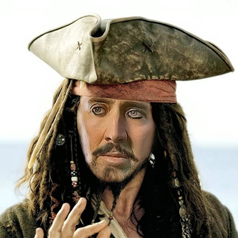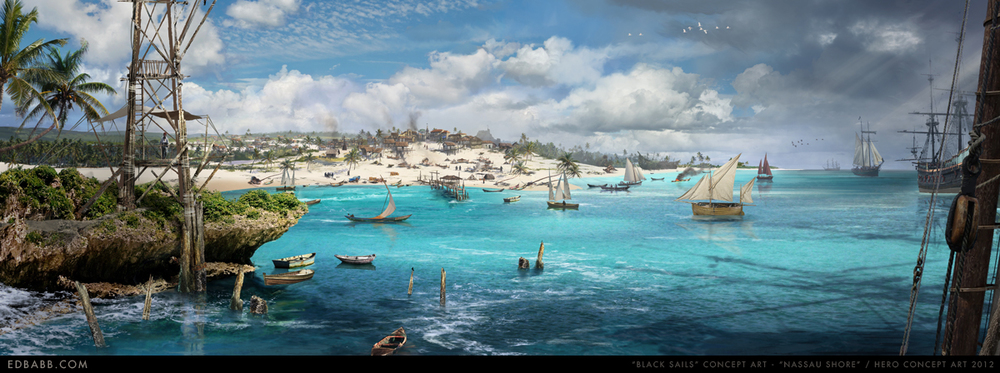GURPS Sea Dogs, Adventure ½
Overview
Another GM in my Saturday group found himself having to slap together a game from scratch with naught but the week before to prepare it, and it ended up working out pretty well, so I wondered if I could pull it off myself. Then the opportunity arose the week prior to this writing, with some upcoming absences from the regular game, and I decided to give it a shot.
I had been wanting to run (or play in) a proper age-of-sail campaign for decades (literally), and have been considering such a campaign for this group, as it has virtually no genre overlap with anyone else’s campaign. But I hadn’t actually put any effort into it yet, so I would be starting from scratch, with only the week to make it happen.
Execution
It took me a few days to finally settle on the basic storyline: a small insurance company based out of Port Royal was about to pay out on a client’s ship lost to pirates, when said client received a ransom demand for the safe return of the ship’s crew—an unusual occurrence—through which the company was able to track down the pirate and his expected location. It would be far cheaper for the company to send some guys with a particular set of skills to retake the ship than to pay out for the loss.
My old Sea Dogs campaign that never saw production started in Nassau, which was also the primary location in the Starz TV series, Black Sails, and a notable spot in the Assassin’s Creed IV game. I chose to set the game there, as there should be plenty of material to work with. The target ship was a 100-ton sloop called McGuffin’s Prize, based on the ship in GURPS Supporting Cast: Age of Sail Pirate Crew for its GURPS 4e stats, captained by the silver-tongued Hans Olof, accompanied by his first-mate, a large African fellow named Chwengwe. Their opposition was a no-name French pirate called La Cage, who captained the brig, Antagonist (which I had to fudge some stats for, in the event they were needed); a brig was featured prominently in the first Pirates of the Caribbean movie, the Interceptor, for plenty of visual references. Captain Olof had convinced the pirates to send the ransom note in order to keep them from killing himself and the crew, knowing that it was highly unlikely that the ransom would actually be paid. Also noteworthy, La Cage had been recruiting crew for the new ship.
To expedite the inevitable planning session, I would use a mechanic I had employed once before, that is, “Planning Points”: a number of Impulse Buys for adjusting the tactical situation with the caveat that the changes had been “pre-planned.” I wanted to do a bit of social engineering in town and that sort of thing, but in order to keep it simple, and enough for one session only, I just stuck with a couple of combat encounters, which, with the planning that would involve, would be a tight fit.
For the characters, I really didn’t care too much what we ended up with. I was going to recommend GURPS Action templates until I remembered Pyramid 3/64 “Pirates and Swashbucklers” issue had a few Dungeon Fantasy “swashbuckler” templates. I created a basic character for everyone to use, at the 250-point DF standard; two of the players created their own, but they were both based on the same template. They were all Weapon Masters—serious badasses—and I knew they were going to wipe the floor (deck) with whomever they encountered.
Other minor points of interest:
- I decided late in the process to use Nicholas Cage as the bad guy, thus named La Cage; I have a long-standing dislike of him as an actor (it’s nothing personal, really), and I like to work him into my campaigns to get punched in the face 😛
- Rigil’s character was an homage to his now-retired Banestorm character, Gabriel
- I had a hard time finding stats for the Antagonist. Low Tech has smaller and larger ships than this brig, but not the same, and 3e Vehicles has a smaller version of both the brig and sloop. I probably could have worked it out properly from Vehicles, but it wasn’t really worth the effort since I wasn’t planning any ship-to-ship combat (though a pursuit was possible).
Synopsis
I started the PCs off at sundown, approaching the handful of pirates holding watch over the ships’ boats on shore, the McGuffin and the Antagonist, anchored together around 75 yards out in the Nassau harbor, just off Potter’s Key. Just trailing the PCs was the former crew of the McGuffin which had been rescued some time before, led by Captain Olof and looking a bit worse for wear from a couple of months neglected in the pirates’ custody—they elected to hang back until the all-clear was given. The only PC with skill in Tactics made the roll, with the others attempting to support; the support didn’t amount to much, resulting in three Planning Points to spend, which they held back for later. One of the PCs brought some bottles of rum, and the four PCs walked right up to the sentries and offered to share, claiming to be recruits. The sentries were caught completely by surprise when their new buddies produced their weapons in a flash and took them all prisoner, binding them and leaving them behind some nearby rocks, before making off with the boats. As GM, I was a little surprised the PCs let the sentries live, but whatever. 😛
After a bit of discussion—which pleased me not to take all night—the former-crew ended up taking two of the boats and rowing out ahead, taking cover in the darkness and waiting for the signal to approach, while the PCs took the third and rowed straight up to the brig, again pretending to be new recruits. I rolled 6d6 for the number of pirates aboard the two ships, and the PCs spent a Planning Point to reduce that number by 1d6, resulting in twenty; around half of them had muskets to hand, the rest cutlasses. La Cage was also aboard, arguing with the men over something-or-other.
As the PCs’ boat passed under the brig’s stern, Ronnke’s character slipped into the water and climbed up to the open gallery windows. They had spent another Planning Point to have an “inside man” disable the rudder—owing to my introduction of Hans Olof and Chwengwe, the players declared the inside-man to be a short, round fellow, wearing blue and white and whistling a lot. Once Ronnke’s character had entered the gallery, the inside-man handed him a dry pistol, while he reloaded one of his.
 I gave La Cage’s men a Reaction check against the newcomers aboard; I interpreted the “Bad” result as the pirates being unappreciative of the the interruption. But they also failed a Perception check to notice the ruse, so I declared Partial Surprise; the PCs won the initiative, and the pirates froze—only one round, though. The PCs went immediately to work butchering them mercilessly, with some minor, flashy heroics combined with some surprise Crit-fails/successes to make things a little more interesting. La Cage fell back across to the McGuffin to regroup but took a nasty spill running down from a cannon and face-planted on deck; Andricus’ character ended up stabbing him twice at random hit-locations: once through the back, the other through his manhood—this was actually unscripted. 😀 The fight lasted around seven seconds, with the enemy casualties a bit over half, the other half choosing to surrender.
I gave La Cage’s men a Reaction check against the newcomers aboard; I interpreted the “Bad” result as the pirates being unappreciative of the the interruption. But they also failed a Perception check to notice the ruse, so I declared Partial Surprise; the PCs won the initiative, and the pirates froze—only one round, though. The PCs went immediately to work butchering them mercilessly, with some minor, flashy heroics combined with some surprise Crit-fails/successes to make things a little more interesting. La Cage fell back across to the McGuffin to regroup but took a nasty spill running down from a cannon and face-planted on deck; Andricus’ character ended up stabbing him twice at random hit-locations: once through the back, the other through his manhood—this was actually unscripted. 😀 The fight lasted around seven seconds, with the enemy casualties a bit over half, the other half choosing to surrender.
Afterward, the signal was given for the old crew to join them. Some of the pirates were recruited to assist as well, and both ships were readied to depart, in no hurry since the pirates were no longer a threat.
Aftermath
The experiment worked out well enough. I managed to craft a decent night’s entertainment from scratch in the allotted week’s time, and probably had enough time to spare that, if I had wanted to spread it out over multiple sessions, I probably could have done more. Now I know, for me, it can be done. There were a few rules bits that I probably could have worked out beforehand, but that was pretty minor. My pacing was spot on; ended exactly when I intended. I was actually a bit surprised that the combat went pretty smoothly and quickly despite the numbers, though that was helped by only having four players to manage. I was also pretty happy with this second playtest of the Planning Points concept; this will undoubtedly be used again.
While I had already been considering a regular age-of-sail campaign, I don’t have any intention of it being a sequel/prequel to this one at all, though some of the characters or ships might certainly reappear in some form or another.




